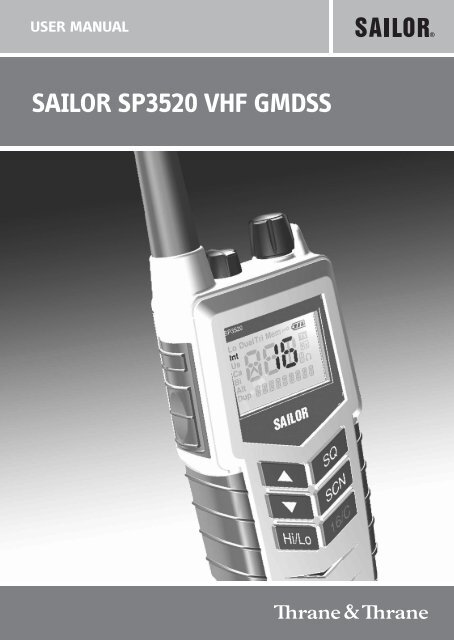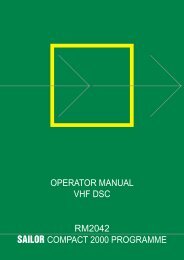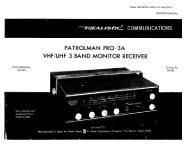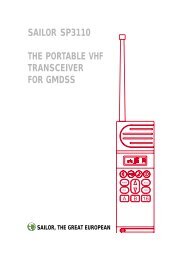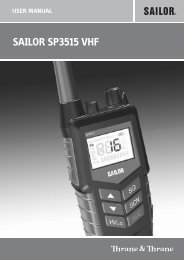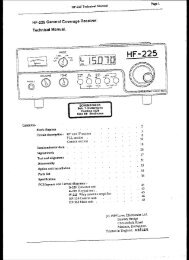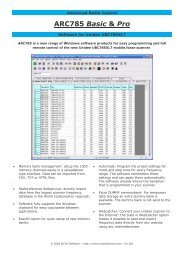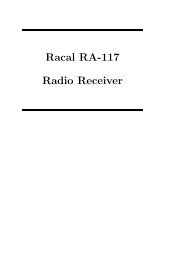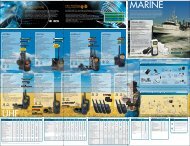SAILOR SP3520 VHF GMDSS
SAILOR SP3520 VHF GMDSS
SAILOR SP3520 VHF GMDSS
Create successful ePaper yourself
Turn your PDF publications into a flip-book with our unique Google optimized e-Paper software.
USER MANUAL<br />
<strong>SAILOR</strong> <strong>SP3520</strong> <strong>VHF</strong> <strong>GMDSS</strong>
Emergency procedure<br />
• Remove the top-seal of the yellow emergency battery package.<br />
• Insert the battery package into the handheld transceiver.<br />
• Turn the knob at the top of the radio clockwise. The display lights<br />
up showing the last used channel and the battery level.<br />
• Select channel 16 (Distress or Safety), press the 16/C key.<br />
• Press the PTT and say:<br />
— “MAYDAY, MAYDAY, MAYDAY”,<br />
— “This is”..... ships name repeated three times<br />
—<br />
— “MAYDAY”<br />
— “This is”..... ships name and call sign,<br />
— The ship’s position in latitude and longitude or other reference<br />
to a known geographical location,<br />
— The nature of distress and assistance wanted,<br />
— Any other information which might facilitate the rescue.<br />
— “OVER”<br />
• Release PTT and listen for answer.<br />
0709
<strong>SP3520</strong> <strong>VHF</strong> <strong>GMDSS</strong><br />
Document number: TT 98-124294-D<br />
Release date: October, 2007<br />
Copyright: © 2007 Thrane & Thrane A/S. All rights reserved.<br />
Trademark Acknowledgements<br />
• <strong>SAILOR</strong> is a registered trademark of Thrane & Thrane A/S.<br />
• Other product and company names mentioned in this manual may be<br />
trademarks or trade names of their respective owners.<br />
Warranty limitation<br />
IMPORTANT - The radio is a sealed waterproof unit. To create and maintain its<br />
waterproof integrity it was assembled in a controlled environment using special<br />
equipment. The radio is not a user maintainable unit, and under no circumstances<br />
should the unit be opened except by authorized personnel. Unauthorized opening<br />
of the unit will invalidate the warranty.<br />
Disclaimer<br />
Any responsibility or liability for loss or damage in connection with the use of this<br />
product and the accompanying documentation is disclaimed by Thrane & Thrane.<br />
The information in this manual is provided for information purposes only, is<br />
subject to change without notice, may contain errors or inaccuracies, and<br />
represents no commitment whatsoever by Thrane & Thrane. This agreement is<br />
governed by the laws of Denmark.<br />
Manuals issued by Thrane & Thrane are periodically revised and updated. Anyone<br />
relying on this information should satisfy himself/herself as to the most current<br />
version. Providers with access to Thrane & Thrane's Extranet may obtain current<br />
copies of manuals at: http://extranet.thrane.com<br />
Thrane & Thrane is not responsible for the content or accuracy of any translations<br />
or reproductions, in whole or in part, of this manual from any other source.<br />
0740<br />
i
Precautions<br />
Avoid water and salt in the I/O connector and keep it<br />
clean frequently.<br />
Only use original Thrane & Thrane battery packs. Make<br />
sure they are clean and dry before attaching the<br />
transceiver. Be careful not to damage any gaskets.<br />
Only use the original Thrane & Thrane charger for the<br />
rechargeable battery.<br />
Be very careful when handling the Lithium batteries.<br />
With correct use they are safe but any misuse might<br />
cause dangerous situations.<br />
Never short circuit the battery terminals, never expose<br />
the transceiver and the batteries to extreme temperature<br />
or fire and never use any kind of violence.<br />
Avoid close contact between the antenna and parts of<br />
the human body. The top of the antenna must never be<br />
closer than 5 cm to the body when transmitting.<br />
Do not submerge the transceiver more than 1 m for 30<br />
minutes.<br />
Keep the transceiver at least 0.3 m away from the<br />
magnetic compass.<br />
ii<br />
0709
Training information<br />
<strong>SAILOR</strong> <strong>SP3520</strong> <strong>VHF</strong> <strong>GMDSS</strong> is designed for "occupational use only". It must be<br />
operated by licensed personnel only.<br />
The <strong>SP3520</strong> complies with the FCC RF exposure limits for "Occupational Use Only".<br />
• FCC OET Bulletin 65 Supplement C, evaluating compliance with FCC guidelines<br />
for human exposure to radio frequency electromagnetic fields.<br />
• American National Standards Institute (C95.1) IEEE standard for safety levels<br />
with respect to human exposure to radio frequency electromagnetic fields,<br />
3 kHz to 300 GHz.<br />
• American National Standards Institute (C95.3) IEEE recommended practice for<br />
the measurement of potentially hazardous electromagnetic fields - RF and<br />
microwaves.<br />
Warning! Your Thrane & Thrane <strong>VHF</strong> radio generates<br />
electromagnetic RF (radio frequency) energy when<br />
transmitting. To ensure that you are not exposed to excessive<br />
amounts of energy and thus to avoid health hazards from<br />
excessive exposure to RF energy, all persons must be at least 5<br />
cm away from the antenna when the radio is transmitting.<br />
Correct use<br />
For best performance, hold the radio vertically and 10 cm away from the head<br />
when talking into the microphone.<br />
0703<br />
iii
iv 0641
Contents<br />
Chapter<br />
Chapter<br />
Chapter<br />
Introduction<br />
Your <strong>VHF</strong> <strong>GMDSS</strong> .................................................................1<br />
Performance .......................................................................2<br />
Channels ............................................................................2<br />
Operation<br />
Controls ..............................................................................3<br />
Keys and buttons ................................................................3<br />
The display .........................................................................5<br />
Using the <strong>VHF</strong> <strong>GMDSS</strong> ........................................................6<br />
Basic functions ...................................................................6<br />
Other functions ...................................................................9<br />
Configuring the <strong>VHF</strong> <strong>GMDSS</strong> ..............................................10<br />
Entering and using configuration mode ............................10<br />
Configuration settings ....................................................... 11<br />
Batteries<br />
Battery types .....................................................................13<br />
The primary battery ...........................................................13<br />
The secondary battery .......................................................14<br />
Battery level indication ......................................................14<br />
Removing and inserting the battery pack ...........................14<br />
The battery charger ...........................................................15<br />
Installing the charger ........................................................15<br />
Recharging the secondary battery .....................................16<br />
0643<br />
v
Chapter<br />
Chapter<br />
App.<br />
App.<br />
Equipment and accessories<br />
External equipment ...........................................................17<br />
List of equipment ...............................................................17<br />
Connecting external equipment .........................................17<br />
Impact on radio operation .................................................18<br />
Accessorie connector .........................................................18<br />
Accessories .......................................................................19<br />
List of accessories ..............................................................19<br />
Attaching and removing the belt clip .................................21<br />
Attaching the lanyard ........................................................21<br />
Troubleshooting<br />
Displaying errors .............................................................. 23<br />
Technical specifications<br />
Technical data <strong>SP3520</strong> ..................................................... 25<br />
General ............................................................................ 25<br />
Transmitter ....................................................................... 26<br />
Receiver ........................................................................... 26<br />
Battery life guidelines ...................................................... 27<br />
Primary battery (non-rechargeable) ................................. 27<br />
Secondary battery (rechargeable) ..................................... 27<br />
Dimensional drawing, transceiver .................................... 28<br />
Dimensional drawing, chargers ....................................... 29<br />
Attention<br />
Goretex Membran .............................................................31<br />
vi<br />
0740
Chapter 1<br />
Introduction<br />
Your <strong>VHF</strong> <strong>GMDSS</strong><br />
<strong>SP3520</strong>, your new <strong>SAILOR</strong> portable <strong>VHF</strong><br />
transceiver, is approved to fulfil the <strong>GMDSS</strong><br />
requirements for portable <strong>VHF</strong> radios for Safety at<br />
Sea and is waterproof to the IP67 standard.<br />
As part of the required safety equipment, the<br />
<strong>SAILOR</strong> <strong>SP3520</strong> is to be used in an emergency<br />
situation. However the best way to guarantee<br />
functionality in an emergency situation, is to use<br />
the radio in daily communication on board.<br />
The <strong>SP3520</strong> is designed for daily use and it<br />
connects easily to external equipment like<br />
headsets and fist mikes, making the <strong>SP3520</strong><br />
suitable for any noisy environment.<br />
The unique battery concept makes the radio<br />
suited for both daily use and emergency<br />
situations. The primary emergency battery is to<br />
be stored for emergency situations and a<br />
secondary rechargeable battery can be used for<br />
daily communication in your new portable <strong>VHF</strong><br />
transceiver.<br />
The radio is designed with a unique man<br />
machine interface, an excellent grip even with<br />
gloves, and large tactile buttons.<br />
0641<br />
1
Introduction<br />
The display has red adjustable backlight which makes the display visible<br />
even at night.<br />
The radio is equipped with a lanyard and a belt clip. A huge accessory<br />
program comes with the <strong>SAILOR</strong> SP3500 series.<br />
Please find the nearest <strong>SAILOR</strong> distributor on www.thrane.com.<br />
Performance<br />
For best performance of the transceiver keep the following in mind:<br />
• Keep clear of metal environment.<br />
• Hold the transceiver vertically and 10 cm from lips and push the PTT<br />
when transmitting.<br />
• In receive mode carry the transceiver vertically with belt clips.<br />
• To preserve battery power, adjust squelch to close the loudspeaker<br />
when there is no signal.<br />
• If you are in a lifeboat keep the antenna as high as possible.<br />
Channels<br />
This radio operates with the following channels:<br />
6 11 15 68 73 77<br />
8 12 16 69 74 87<br />
9 13 17 71 75 88<br />
10 14 67 72 76<br />
Notes:<br />
• All channels are Simplex.<br />
• Tx power is limited to 1 W on<br />
channels 75 and 76.<br />
2<br />
0703
Chapter 2<br />
Operation<br />
Controls<br />
Keys and buttons<br />
1. On/off/volume<br />
2. Light/Lock<br />
3. Push To Talk (PTT)<br />
4. Up key<br />
5. Down key<br />
6. Hi/Lo output power<br />
7. Squelch<br />
8. Scan<br />
9. Priority channel (16)/<br />
Call channel<br />
10. Loudspeaker/microphone<br />
2<br />
3<br />
4<br />
5<br />
6<br />
1<br />
7<br />
8<br />
9<br />
10<br />
0740<br />
3
Operation<br />
Key presses<br />
Pressing and holding certain keys gives access to additional functions,<br />
shown in the table below.<br />
Key<br />
Short press<br />
(1 beep)<br />
Long press<br />
(2 beeps)<br />
Extra long<br />
press<br />
(3 beeps)<br />
Show next available<br />
item in the list (up or<br />
down).<br />
Default: Channel<br />
selection<br />
Run through available<br />
items, or<br />
select tagged channels<br />
A () or B ().<br />
Run through<br />
available<br />
items if an A<br />
or B channel<br />
is tagged<br />
Activate Squelch<br />
control (Adjust with<br />
up/down arrows).<br />
Monitor function. Open<br />
Squelch completely.<br />
1 press: Activate/<br />
terminate Dual/Triple<br />
watch.<br />
Add/Delete channel<br />
from memory scan.<br />
2 presses: Activate<br />
memory scan.<br />
Toggle between high<br />
and low transmitter<br />
power.<br />
Select channel 16.<br />
Select programmed<br />
Call channel.<br />
Program Call<br />
channel.<br />
4<br />
0703
Operation<br />
The display<br />
The display holds various fields of information, explained below.<br />
4 5 6<br />
3<br />
2<br />
1<br />
7<br />
8<br />
9<br />
10<br />
1. Current working channel.<br />
2. Current channel mode.<br />
3. “Lo”: Reduced transmitter power.<br />
Full transmitter power is not shown in display.<br />
4. Dual watch activated.<br />
5. Current working channel is marked for scanning.<br />
6. Keypad is locked.<br />
7. Battery level indicator.<br />
8. Transmitting (Tx) /Receiving (Rx).<br />
9. Accessory is connected.<br />
10. Service line for various purposes. In this example the volume level.<br />
0643<br />
5
Operation<br />
Using the <strong>VHF</strong> <strong>GMDSS</strong><br />
Basic functions<br />
Note<br />
Before using the radio, mount the antenna at the top of the<br />
radio. The antenna is delivered with the radio.<br />
Switching the radio on and off<br />
• To switch the radio on, turn the knob at the top<br />
of the radio clockwise.<br />
The display lights up showing the last used<br />
channel and the battery level.<br />
• To switch the radio off, Turn the knob back<br />
counter-clockwise until it clicks.<br />
Selecting the working channel<br />
• To select channel 16 (Distress or Safety), press the 16/C key.<br />
• To select the Call channel, use a long press on 16/C.<br />
• To select among all available channels, press or on the keypad.<br />
For fast selection, press and hold or .<br />
The display shows the currently selected channel.<br />
Note<br />
Long press on or can also be used to select preferred<br />
channels. For information on how to program preferred<br />
channels, see Configuring the <strong>VHF</strong> <strong>GMDSS</strong> on page 10.<br />
6<br />
0643
Operation<br />
Activating a call<br />
To activate a call to the selected channel, press and<br />
hold the PTT button on the side of the radio.<br />
The radio transmits as long as the PTT button is<br />
pressed. A small Tx sign next to the channel number<br />
indicates when the radio is in transmit mode.<br />
Adjusting the volume<br />
• To increase the volume, turn the on/off knob at the top of the radio<br />
clockwise.<br />
• To decrease the volume, turn the knob counter-clockwise.<br />
The display shows the level of the volume, e.g. “VOL 5”, while it is<br />
adjusted.<br />
Using Squelch control<br />
• To activate Squelch control, press the SQ key.<br />
• To set the Squelch level, press (closing) or (opening). The<br />
display shows the Squelch level while it is adjusted, e.g. “SQ 5”.<br />
Adjusting the display backlight<br />
• To turn on the backlight, press the<br />
Light/Lock button on the side of the radio.<br />
• To adjust the backlight level, press or <br />
within 3 seconds after turning on the light.<br />
The display shows the level while it is<br />
adjusted, e.g. “DIM MED”.<br />
0643<br />
7
Operation<br />
Using Dual watch<br />
To activate Dual watch, press the SCN key.<br />
The display shows “Dual” at the top and “16” at the bottom right.<br />
The radio toggles between the selected channel and channel 16.<br />
• To terminate Dual watch, press SCN again.<br />
Scanning channels<br />
• To activate scanning memory, press 2 times SCN within 2 seconds.<br />
During scanning, the display shows “SC” in the channel field. The<br />
radio toggles between channel 16 and each of the channels marked<br />
for scanning.<br />
• To terminate scanning, press SCN once.<br />
Changing the transmitter power<br />
To change the transmitter power, press the Hi/Lo key. The display shows<br />
“Lo” when power is set to low. Otherwise maximum power is used.<br />
Locking the keypad<br />
• To lock the keypad, press and hold the Light/Lock button. The display<br />
shows a key symbol when the keypad is locked.<br />
• To unlock the keypad, press and hold the Light/Lock button again.<br />
8<br />
0740
Operation<br />
Other functions<br />
Programming the Call channel<br />
To program the Call channel, do as follows:<br />
1. Press and hold 16/C until the current Call channel number is flashing.<br />
2. Select the channel with or .<br />
3. Press 16/C to confirm.<br />
Programming the scanning memory<br />
To add a channel to the scanning memory, select the channel and then<br />
press and hold the SCN key until the display shows MEM at the top.<br />
To remove a channel from the scanning memory, select the channel and<br />
then press and hold the SCN key until the MEM sign disappears from the<br />
display.<br />
0740<br />
9
Operation<br />
Configuring the <strong>VHF</strong> <strong>GMDSS</strong><br />
Entering and using configuration mode<br />
Note<br />
The radio is not operational in configuration mode.<br />
• To enter configuration mode, press and hold the Light/Lock button<br />
while turning on the radio.<br />
The bottom line of the display shows the current menu item/setting.<br />
• To exit configuration mode, turn off the radio or press any key except<br />
, and the Light/Lock button.<br />
Using the PTT button or leaving the radio inactive for 10 seconds also<br />
causes the radio to exit configuration mode.<br />
• To change a setting, press or .<br />
• To confirm the current setting and go to the next menu item, press the<br />
Light/Lock button.<br />
10<br />
0643
Operation<br />
Configuration settings<br />
Configuration mode is used to program preferred channels and volume of<br />
key beep and battery alarm.<br />
The following settings are available in configuration mode.<br />
BEEP MAX Status click/beep sound on key press, long<br />
press (settings/programming saved) and<br />
battery alarm. Maximum level.<br />
MIN<br />
OFF<br />
Status click/beep sound on key press, long<br />
press (settings/programming saved) and<br />
battery alarm. Minimum level.<br />
All beeps off.<br />
PREFA OFF Remove tag “A” for current working channel.<br />
ON<br />
Tag current working channel with “A”. If<br />
another channel was previously tagged “A”,<br />
this is overruled.<br />
• The working channel can now be selected<br />
with a long press on .<br />
PREFB OFF Remove tag “B” for current working channel.<br />
ON<br />
Tag current working channel with “B”. If<br />
another channel was previously tagged “B”,<br />
this is overruled.<br />
• The working channel can now be selected<br />
with a long press on .<br />
VER X.XX.XX Software version. Read-only.<br />
0703<br />
11
Operation<br />
12 0643
Chapter 3<br />
Batteries<br />
Battery types<br />
• The yellow primary battery pack contains a non-rechargeable Lithium<br />
battery. This battery pack is only to be used in case of emergency.<br />
• The black secondary battery pack contains a rechargeable battery.<br />
This battery pack is for daily use.<br />
The primary battery<br />
Important<br />
The yellow primary battery pack is only for emergency use,<br />
and is not rechargeable.<br />
Before using the primary battery, remove the seal on the battery pack.<br />
Then do as follows:<br />
1. Attach the battery pack to the radio as<br />
shown.<br />
2. Lock the battery with the safety lock at the<br />
bottom.<br />
The primary battery is capable of providing<br />
sufficient power for 8 hours of operation defined<br />
as 10% Tx, 10% Rx and 80% standby.<br />
When the primary pack is not in use it must<br />
always be placed in the dedicated rear position<br />
in the charger cradle, see The battery charger on<br />
page 15.<br />
2<br />
1<br />
0709<br />
13
Batteries<br />
The secondary battery<br />
Battery level indication<br />
The black secondary battery pack is for daily use of the radio. When the<br />
battery level is low, you should recharge the battery.<br />
The radio display shows the battery<br />
status. When the battery symbol is empty<br />
and flashing, the battery should be<br />
recharged as soon as possible.<br />
Removing and inserting the battery pack<br />
To remove the battery pack, do as follows:<br />
1. Open the safety lock as shown.<br />
2. Remove the battery.<br />
To insert the battery pack, attach the battery<br />
and close the safety lock as shown on the<br />
previous page.<br />
2<br />
1<br />
14<br />
0643
Batteries<br />
The battery charger<br />
The chargers has two compartments.<br />
CH3507<br />
• A rear compartment only for<br />
storing a spare battery. It does not<br />
have a charger function.<br />
• A front compartment for<br />
recharging the battery alone or<br />
while attached to the radio.<br />
CH3508<br />
• It is possible to charge a battery in<br />
rear compartment simultaneously<br />
with the radio/battery in front.<br />
Installing the charger<br />
Mounting the charger<br />
There are several options for<br />
mounting one or more chargers on a<br />
table or a wall.<br />
For information on dimensions and<br />
screw positions, refer to Dimensional<br />
drawing, charger on page 27.<br />
When mounting the charger, make<br />
sure it is placed in a dry place and<br />
away from direct sunlight. The<br />
charger is not waterproof.<br />
0740<br />
15
Batteries<br />
Connecting to power<br />
The charger can be supplied with DC or AC.<br />
DC: Connect the 12-24VDC Connection Cable between the DC supply and<br />
the connector on the underside of the charger.<br />
AC: Connect the AC/DC adapter to the connector on the underside of the<br />
charger. Then connect the AC/DC adapter to the AC outlet.<br />
Recharging the secondary battery<br />
Important<br />
Do not attempt to recharge the yellow primary battery!<br />
To recharge the secondary battery, place the radio 1 with battery or the<br />
battery alone in the front position of the charger cradle.<br />
The light indicators on the charger cradle show the status as follows:<br />
• Green light: Power is connected to the charger.<br />
• Slow red flash: Charging in progress.<br />
• Quick red flash (twice per second): Charging error, e.g. battery<br />
defect or temperature out of range.<br />
• Steady red light: Charging completed. Trickle charge mode.<br />
Charging time with emtpy battery: <strong>VHF</strong> off<br />
approx. 4 hours, <strong>VHF</strong> on: approx. 5 hours.<br />
The battery indicator on the radio display<br />
indicates if the radio is placed in the<br />
charger while radio and charger are both<br />
powered.<br />
16<br />
1. The radio may be left on or it may be switched off during the recharge<br />
process.<br />
0740
Chapter 4<br />
Equipment and accessories<br />
External equipment<br />
List of equipment<br />
The following equipment can be connected to the radio:<br />
• SAVOX 400E Push-To Talk unit<br />
• SAVOX C500 Fist Mike<br />
• SAVOX NC/400 Noise-com<br />
• SAVOX HC-E Helmet-com<br />
• SAVOX K53004 Helmet unit<br />
• Peltor MT7H79 Headset<br />
We recommend to remove all accessories during emergency use.<br />
All accessories listed might be used when body worn.<br />
Connecting external equipment<br />
Connect the dedicated interface cable between the external equipment<br />
and the top connector on the radio.<br />
Interface cable<br />
Order number<br />
For SAVOX 400E 403500-940<br />
For SAVOX C500 403500-950<br />
For Peltor FL5061 403500-951<br />
0740<br />
17
Equipment and accessories<br />
When external equipment is connected<br />
to the radio, the right side of the display<br />
will show a headset.<br />
Impact on radio operation<br />
The external equipment can have a built-in PTT, speaker and<br />
microphone. Thus connecting it to the radio will have the following<br />
impact on the radio operation:<br />
• If a microphone is built into the detected external equipment, the<br />
external equipment microphone is used, and the internal radio<br />
microphone is disabled.<br />
• If a speaker or earpiece is built into the detected external equipment,<br />
the external equipment sound device is used, and the internal radio<br />
speaker is disabled.<br />
• If a PTT or VOX is built into the detected external equipment, the<br />
external equipment PTT control is used, and the radio PTT button is<br />
disabled.<br />
Accessorie connector<br />
Pin 1. Loudspeaker,<br />
minimum 8 ohm impedance.<br />
Pin 2. Accessory power,<br />
5V maximum 0.03A.<br />
Pin 3. Microphone input,<br />
Ri = 2.2kohm, 3V phantom power.<br />
Pin 4. GND<br />
18<br />
0740
Equipment and accessories<br />
Accessories<br />
List of accessories<br />
The following accessories are delivered with your radio:<br />
Accessory<br />
Primary battery (yellow, non-rechargeable), B3501<br />
Secondary battery (black, rechargeable), B3502<br />
Charger, CH3507<br />
Part number<br />
403501A<br />
403502A<br />
403507A<br />
AC/DC converter, length 150cm (100-240V~ /12VDC out) 88-125538<br />
12-24VDC Connection cable, length 150cm 37-124381<br />
Belt clip 62-124320<br />
Antenna 88-124370<br />
Lanyard 41-124375<br />
<strong>SP3520</strong> User Manual (this manual) 98-124294<br />
Batteries, charger, AC/DC Converter and 12VDC Connection are described<br />
in Batteries on page 13.<br />
To mount the antenna, simply screw it into the threaded bush at the top<br />
of the radio.<br />
Use of lanyard is only for hand held operation. Put it around the wrist to<br />
prevent dropping the radio.<br />
0740<br />
19
Equipment and accessories<br />
Accessories you may buy<br />
Dual Position Charger CH3508<br />
Accessory<br />
Part number<br />
403508A<br />
Leather Case 403500-205<br />
Leather Case<br />
Warning!<br />
The display must always be kept away from the body to reduce the RF<br />
exposure when body worn.<br />
20<br />
0740
Equipment and accessories<br />
Attaching and removing the belt clip<br />
To attach the belt clip, slide the belt clip upwards<br />
into the rails at the back of the radio until it locks.<br />
To remove the belt clip, press the projection at<br />
the top of the belt clip to release the lock and<br />
slide the belt clip downwards out of the rails.<br />
Release lock<br />
Attaching the lanyard<br />
Do as follows:<br />
1. Take the lanyard through the<br />
eye at the top of the radio.<br />
2. Put one end of the lanyard<br />
through the loop at the other<br />
end of the lanyard and pull to<br />
tighten.<br />
0740<br />
Top view<br />
21
Equipment and accessories<br />
22 0740
Chapter 5<br />
Troubleshooting<br />
Displaying errors<br />
Some errors result in an error message in the display. These error<br />
messages are listed below.<br />
Display text Problem Type Actions<br />
Err<br />
EMPTY BAT<br />
The battery voltage is<br />
below a critical level,<br />
where further operation<br />
would damage the battery.<br />
Severe.<br />
Radio is nonfunctional.<br />
Change/recharge<br />
the battery.<br />
Err<br />
HW ERR<br />
Hardware error.<br />
Severe.<br />
Radio is nonfunctional.<br />
Service required.<br />
ILLEGAL<br />
Context fails operation.<br />
This text will appear on<br />
the following occasions:<br />
• Multiple watch is<br />
selected on channel 16,<br />
or in channel regions<br />
where it is not allowed.<br />
• High power is selected<br />
on a channel where it is<br />
prohibited.<br />
• Transmission on<br />
blocked channels<br />
Fail<br />
operation<br />
Consider operation<br />
in a different<br />
context.<br />
0740<br />
23
Troubleshooting<br />
24 0740
Appendix A<br />
Technical specifications<br />
Technical data <strong>SP3520</strong><br />
General<br />
Item<br />
RX frequency range<br />
TX frequency range<br />
Modulation<br />
Power supply<br />
Current drain at 2 W TX<br />
Current drain at 1 W TX<br />
Current drain RX max audio<br />
Antenna port<br />
Primary Battery<br />
Secondary Battery<br />
Operating temperature<br />
Water ingress protection<br />
Frequency stability<br />
Weight with emergency battery<br />
Specification<br />
155.000 - 163.425 MHz<br />
155.000 - 161.450 MHz<br />
16K0G3E<br />
7.2 VDC Li battery<br />
1.4 A<br />
0.8 A<br />
0.25 A<br />
50 ohm<br />
Lithium Iron Disulfide, 3000 mAh<br />
Lithium-Ion, 1800 mAh rechargeable<br />
-20°C to +55° C<br />
IP67<br />
Better than ±0.7 kHz<br />
340g<br />
0740<br />
25
Technical specifications<br />
Transmitter<br />
Item<br />
RF output power<br />
RF output power, Canada<br />
Max deviation<br />
Spurious emission<br />
Adjacent channel power<br />
Specification<br />
2 W /1 W<br />
2.5 W ±1 dB / 0.75 W ±1 dB<br />
±5 kHz<br />
< 0.25 uW<br />
> 70 dB<br />
Receiver<br />
Item<br />
Sensitivity (20 dB SINAD)<br />
Intermodulation<br />
Spurious response<br />
Adjacent channel selectivity<br />
Audio output, internal<br />
Audio output, external<br />
Specification<br />
-117 dBm typical<br />
Better than 70 dB<br />
> 70 dB<br />
> 70 dB<br />
0.25 W at 10% dist.<br />
0.25 W/8 ohm<br />
26<br />
0740
Technical specifications<br />
Battery life guidelines<br />
Primary battery (non-rechargeable)<br />
The primary non-rechargeable battery pack is capable of providing<br />
sufficient power for the specified 8 hours according to regulations.<br />
The battery is marked with an expiry date. Replace the battery at or<br />
before this date.<br />
To ensure a long lifetime keep the battery in the store position in the<br />
charger and avoid high temperature and direct sunlight.<br />
Secondary battery (rechargeable)<br />
Note New batteries should be placed in the charger for minimum 12<br />
hours first time.<br />
During daily use, always keep the battery fully charged and away from<br />
hot areas.<br />
Keep the battery terminals dry and clean.<br />
Never discharge beyond the specifications of the battery.<br />
Operation/Standby time depends on usage. Generally, the more the radio<br />
is transmitting, the faster it will drain the battery. Also, the “Hi” power<br />
setting will drain the battery faster than the “Lo” setting.<br />
Approximate figures are:<br />
• A battery can be stored for 4 to 6 month at 25°C if charged to 25%.<br />
• The battery will normally last for 5 to 9 hours of use on a fully<br />
charged battery.<br />
0709<br />
27
Technical specifications<br />
Dimensional drawing, transceiver<br />
28<br />
0709
Technical specifications<br />
Dimensional drawing, chargers<br />
Mounting Possibillities<br />
Desktop mounting, top view<br />
Wall mounting, rear view<br />
0740<br />
29
Technical specifications<br />
30 0703
Appendix B<br />
Attention<br />
Goretex Membran<br />
To keep the <strong>VHF</strong> watertight, is it very important that the goretex membran<br />
behind the label under no circumstances must be damaged or removed.<br />
0740<br />
31
Attention<br />
32 0740
TT-98-124294-D Issue: D/0740<br />
Thrane & Thrane A/S • info@thrane.com • www.thrane.com


